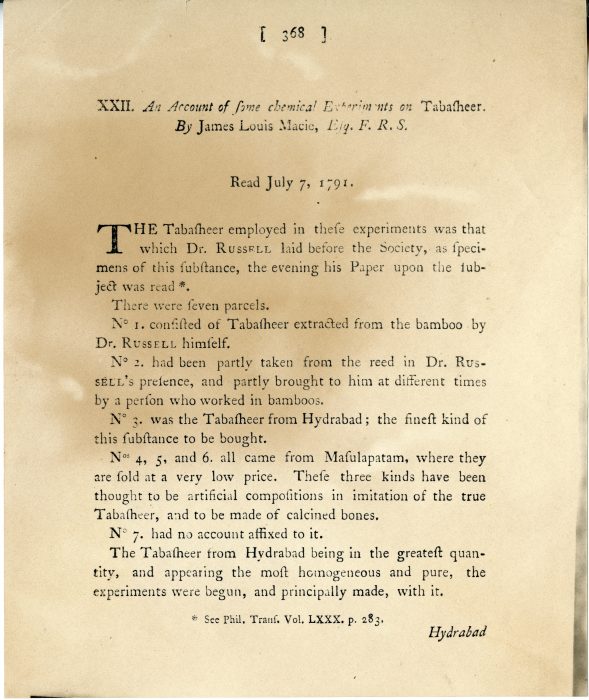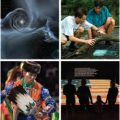The Science of James Smithson
Insomniac, aristocrat, gambler, philanthropist—James Smithson also was an indefatigably curious chemist who deserves more credit for his contributions to science.
James Smithson (1765-1829), the British chemist who founded the Smithsonian Institution, published some 26 articles in scientific journals during his lifetime. Most of them closely examined the properties of little-known chemical elements and included titles such as “An Account of Some Chemical Experiments on Tabasheer (1791),” “On a Substance from the Elm Tree Called Ulmin (1813),” and “An Account of a Native Combination of Sulphate of Barium and Flouride of Calcium (1820).”
According to Steven Turner, retired Curator of Scientific Instruments at the Smithsonian’s National Museum of American History and author of the new book The Science of James Smithson: Discoveries from the Smithsonian Founder (Smithsonian Books), as many as 200 additional unpublished articles were among Smithson’s belongings which came to the United States along with his fortune in gold sovereigns in 1838. However, all those articles and most of his other papers were destroyed in a fire in the Smithsonian Castle in 1846.

“As an historian, studying Smithson is a major problem because of the lack of material,” Turner observes. “That is why I looked so carefully at all his known scientific articles. They hadn’t really been addressed by previous biographers. After a lot of work, I was able to make sense of them, and by then placing them in context, came up with what I think are some interesting discoveries and new material.”
Here, Turner answers a few questions about how he researched his book and what he learned about the Smithsonian’s founder.
Did you need to travel outside the United States to examine original copies of Smithson’s published papers?
I definitely had to go to London, to the Royal Society, they still have eight of his original papers there, and these were enormously helpful. Several had footnotes with personal material that had not been published, leading to information about his relationship with his father and his relationships with other scientists. This material was really quite surprising.
I also went to the French Academy in Paris, which had more interesting material. While not everything made into the book, it established it established context, so as a writer it was much easier to imagine Smithson’s situations and these locations once I had actually seen them.
Smithson was so interesting that the research was a real joy. I loved going to the Royal Society and I loved learning about French science in the 18th century.
Can you briefly describe James Smithson the scientist?
He was a scientific figure but not the kind of scientist that we think of today. He never worked for anyone or had an occupation because he was independently wealthy. He never taught, he didn’t write any books and as near as I can tell he didn’t present any papers. He would submit articles to the Royal Society, but he never read papers or gave lectures or anything like that. He was completely self-funded.
For Smithson, science was more of a lifestyle than an occupation. In his time, being a scientist was not something you did, but rather it was who you were. And in keeping with that, it was common for scientists to customize their instruments to fit with how they lived. In Smithson’s case, because he spent long periods traveling, generally in carriages or on horseback, it was difficult for him to carry the large, delicate instruments one would use in a laboratory. So, he developed scientific instruments that were small enough and rugged enough to withstand the rigors of travel.
Over time he developed a kind of microchemistry. Toward the end of his life, he could carry most of the scientific instruments he needed in the pockets of a large coat. It was really quite amazing.
It seems Smithson contributed more to science than he has been given credit for in the last 200 years.
That is correct. That is the fundamental premise at the center of the book. Smithson’s work as a scientist was of far greater consequence than previously thought. I’ve worked at the Smithsonian for 32 years and it was good to find new material about its founder. It was a nice way to give back to the Institution, to tell a new story about the founder and maybe elevate him a bit higher than he’d been regarded before.
One hidden question behind any study of Smithson is just what motivated him to found the Smithsonian, and why he did it in Washington, D.C. rather than in Europe. Smithson never came to the United States and he never had any formal contact with the U.S. Government. He didn’t do any prep work for founding the Smithsonian Institution, he just sent his money over here with a note to the government to make an institution to increase and diffuse knowledge. I tried to give some insight into Smithson’s personality and address that question some extent.
I got the impression that Smithson never seriously expected his nephew not to take and use his money. He never expected the clause in his will about founding the Smithsonian in the United States would really be used. He seemed to include that clause as a last resort, an afterthought. He didn’t think it would ever come to that, but it did.
Heather Ewing published The Lost World of James Smithson, Science, Revolution, and the Birth of the Smithsonian in 2007. Now comes your very detailed book. Is there anything else out there to learn about Smithson?
Well, that’s the big question, of course. There is actually quite a bit of information that I uncovered that didn’t make it into the book. And things that, you know, maybe deserve a little closer look, particularly, the idea that Smithson was interested in worker education and that Smithson was more politically active than we thought.
In some ways Smithson may have been a radical, a political radical, at least for his times. He was against the monarchy. So, in his time that made him a radical. In our time, of course, that’s hardly seen as an outrageous position.
I think he was more of an idealist rather than someone who was against the monarchy for personal reasons. But anyway, that’s a topic that I would like to investigate: the influences that led Smithson to some of his decisions, particularly the founding of the Smithsonian. Hopefully in a couple of years I’ll have something interesting to say on that. Its almost an act of love for me to keep going with this story
One aspect to Smithson the scientist that comes out in your book was that he used and developed a variety of scientific instruments to conduct his experiments.
Very much so and, unusual for the time, he wrote about these things. Most chemists made at least some of their own instruments, but very few ever put anything in print about this. So, Smithson is a really good source for that kind of information. My hope is that all the details I have in the book will be of use to future historians when they start looking at other chemists from that period.
Another thing I did in researching Smithson is that I recreated most of his experiments and did so using period examples of the tools he used. That was a really very interesting experience.
When someone makes a scientific tool, they usually optimize it to be used in a particular way. And the way a tool is made (and used) often determines what can be learned with it. So, tools can be seen as sources of information, and the stories they tell sometimes lead somewhere, providing new information or new insights into what Smithson was doing. This was extremely helpful.
Where did you find the antique implements you used?
Well, I mean, I was Curator of Scientific Instruments at the American History Museum for all those years, so I had a few connections. There are antique scientific instrument dealers that you can contact and there are private collectors. But for some of Smithson’s instruments I was simply able to make them just as Smithson had done.
Your book reveals that Smithson had arthritis toward the end of his life, and as a result had trouble sleeping so he stayed up gambling.
Right. The poor guy. He was trying to keep going but was just racked with pain. I read accounts of him from his last days when he was in Paris and Smithson was just miserable, but he continued to have an intellectual life. He continued to pursue new knowledge and have relationships with other scientists. He was remarkably determined. I admire that in him. He didn’t lose his idealism and he never really gave up. He kept trying to find new knowledge.
He was also a smoker?
That seems to be the case. Like most people at the time, he used a small clay pipe and there is some evidence of wear on his teeth from that. As a chemist Smithson also used a clay pipe for his experiments. He used it to hold materials and put them in a fire to examine their reactions. So, these clay pipes became part of his scientific tool kit. They also were inexpensive and easy to travel with.

Previous Smithson biographers did not turn up any evidence that Smithson had any close personal relationships with other people—romantic or otherwise. From your book, his primary relationships appear to have been professional with other scientists.
Very much so and these were interpersonal relationships with what are now famous scientific figures. Smithson seemed to have known everybody but there is no evidence of any romantic entanglements in his life. He had women friends and was very devoted to several of them but that is as far as it seems to have gone.
He had scientist friends with whom he wrote back and forth for decades. During his travels he would go out of his way to meet these people, traveling hundreds of miles to meet a particular chemist whose works he had read. Smithson sought these people out.
Is there anything else you would like people to know about The Science of James Smithson?
I’ve been working on this book for more than 10 years—it was really a labor of love—and one of the things I never let myself think about was that people would actually be reading this. I just tried to make it as good as I could and then sent it out into the world. So, it’s been really satisfying that the reviews have been good and people are reading it.
For me, the main purpose of this book has always been to present a new understanding of Smithson and his science. The stories I tell about him are often complex – just as he was. But I tried to write the book so it would still be accessible to students, and it is my hope that these stories will resonate with students on many levels and encourage them to learn more about science and its history.

James Smithson is best known as the founder of the Smithsonian Institution, but few people know his full and fascinating story. He was a widely respected chemist and mineralogist and a member of the Royal Society, but in 1865, his letters, collection of 10,000 minerals, and more than 200 unpublished papers were lost to a fire in the Smithsonian Castle. His scientific legacy was further written off as insignificant in an 1879 essay published through the Smithsonian fifty years after his death–a claim that author Steven Turner demonstrates is far from the truth.
By providing scientific and intellectual context to his work, The Science of James Smithson is a comprehensive tribute to Smithson’s contributions to his fields, including chemistry, mineralogy, and more. This detailed narrative illuminates Smithson and his quest for knowledge at a time when chemists still debated thing as basic as the nature of fire, and struggled to maintain their networks amid the ever-changing conditions of the French Revolution and the Napoleonic Wars.
Posted: 23 February 2021
- Categories:







